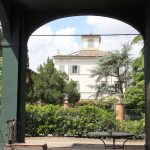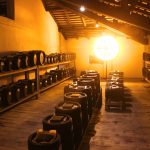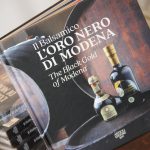Visitare un’acetaia
5 Giugno, 2023 Published in Food & Beverage
Sono andata a scoprire come nasce l’oro nero di Modena, ossia il famoso aceto balsamico. Passando sotto un portico del Settecento si accede alla leggendaria Acetaia Fabbi che fu aperta nel 1969 e ad oggi, dopo essere stata tramandata per quattro generazioni, è diventata proprietà di Massimo Bottura e di sua moglie Maria Luigia. Ad oggi ospita oltre 1.200 botti di Aceto Balsamico Tradizionale di Modena le più antiche delle quali risalgono al 1900. Visitare un’acetaia è un’esperienza immersiva che ci fa conoscere tradizioni antiche. Le botti non vengono mai svuotate completamente, ma rimane sempre una quantità di vecchio aceto che va ad arricchire il nuovo al quale tramanda sapori e magia.
La storia dell’Aceto Balsamico Tradizionale è indissolubilmente legata al territorio modenese, grazie al suo microclima è l’unico luogo dove esso può essere prodotto, ma le sue origini sono antichissime. Vi sono tracce già intorno al 4000 a.C., i Babilonesi lo ricavavano facendo fermentare datteri, fichi, albicocche e lo usavano come condimento o per conservare altri alimenti. I Greci hanno introdotto la coltivazione della vite nei territori della Magna Grecia e da loro i Romani hanno imparato a produrre vino e aceto, utilizzato per la conservazione dei cibi, come medicinale e come condimento. Alcune famiglie modenesi si tramandavano in segreto la ricetta dell’aceto balsamico tradizionale che veniva custodito e curato dalle donne della famiglia e lasciato in dote perché considerato un bene raro e prezioso.
Questo tipo d’aceto nasce da mosti cotti d’uve provenienti esclusivamente dalla province di Modena e Reggio Emilia, fermentati, acetificati e poi invecchiati per almeno dodici anni. Deve essere certificato e imbottigliato in speciali bottigliette da 100 ml, di vetro bianco massiccio, sferiche con base rettangolare, disegnate in esclusiva dal designer Giorgetto Giugiaro.
I went to know how the Modena black gold is born, the famous balsamic vinegar. Passing under a eighteenth century portico we enter the legendary Acetaia Fabbi, it was opened in 1969 and today, after being handed down for four generations, has become the property of Massimo Bottura and his wife Maria Luigia. Today it houses over 1,200 barrels of Modena Traditional Balsamic Vinegar, the oldest of which date back to 1900. Visiting an acetaia is an immersive experience that introduces us to ancient traditions. The barrels are never emptied completely, but there is always a quantity of old vinegar that enriches the new one to which it passes on flavors and magic. The history of Traditional Balsamic Vinegar is inextricably linked to the Modena area, thanks to its microclimate it is the only place where it can be produced, but its origins are ancient. There are traces already around 4000 BC, the Babylonians obtained it by fermenting dates, figs, apricots and used it as a condiment or to preserve other foods. The Greeks introduced the cultivation of vines in the territories of Magna Graecia and from them the Romans learned to produce wine and vinegar, used for food preservation, as a medicine and as a condiment. Some Modena families secretly handed down the recipe of traditional balsamic vinegar that was kept and cared for by the women of the family and left as a dowry because it was considered a rare and precious asset. This type of vinegar comes from cooked grape musts coming exclusively from the provinces of Modena and Reggio Emilia, fermented, acetified and then aged for at least twelve years. It must be certified and bottled in special 100 ml bottles of solid white glass, spherical with rectangular base, designed exclusively by the designer Giorgetto Giugiaro.
www.casamarialuigia.com/it/acetaia-maria-luigia/ – www.facebook.com/dolcissimame.it/






